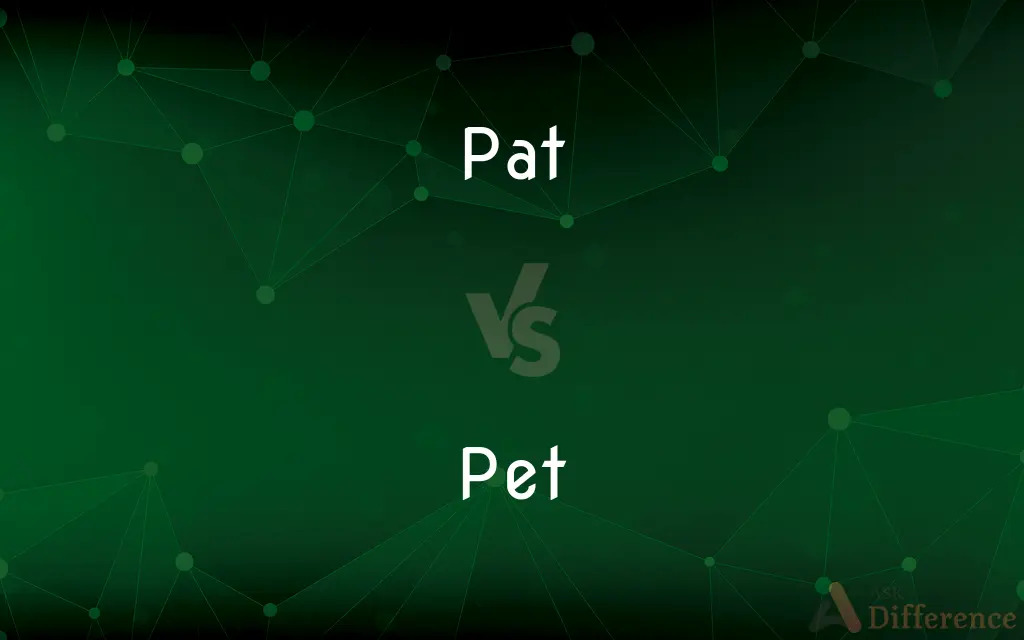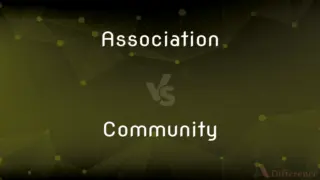Pat vs. Pet — What's the Difference?
By Fiza Rafique & Urooj Arif — Updated on April 4, 2024
Pat involves tapping lightly with a flat hand, often as a sign of affection or comfort, whereas petting is a more prolonged, gentle stroke, typically used to show affection to animals.

Difference Between Pat and Pet
Table of Contents
ADVERTISEMENT
Key Differences
A pat is a quick, light touch or tap with the hand, often used to show affection, offer comfort, or as a gesture of approval.Petting, on the other hand, involves more extended and often repetitive strokes with the hand, usually performed on animals as a way of showing affection or calming them.
While a pat is often delivered with the palm or fingertips and is relatively brief, petting requires the whole hand to move smoothly over an animal's fur or a person's skin. The duration and motion involved in petting make it a distinctly more involved form of tactile interaction than a simple pat.
Pets, especially domesticated animals like dogs and cats, usually respond positively to petting, seeing it as a sign of affection and security. Humans, on the other hand, may interpret a pat in various ways depending on the context, from a friendly gesture to a patronizing one.
The intention behind a pat is typically to acknowledge or congratulate, without necessarily seeking to establish a deeper emotional connection. In contrast, petting is often about fostering a sense of closeness and comfort, making it a more emotionally charged action.
Comparison Chart
Duration
Brief, momentary
Prolonged, continuous
ADVERTISEMENT
Technique
Light tap with palm or fingertips
Smooth strokes with the whole hand
Intention
Comfort, acknowledgment, approval
Affection, comfort, bonding
Common Recipients
Humans and animals
Primarily animals, occasionally humans
Emotional Depth
Less intimate
More intimate
Compare with Definitions
Pat
An action to apply or smooth down.
She patted the soil around the newly planted flowers.
Pet
An act of bonding between humans and animals.
Daily petting has strengthened the bond between him and his dog.
Pat
A sign of approval or encouragement.
The coach gave the player a pat on the back after a well-played game.
Pet
A technique in animal training and therapy.
Pet therapy involves petting to reduce stress in patients.
Pat
A light, quick touch or stroke with the hand.
She gave the child a comforting pat on the head.
Pet
Stroking an animal gently as a sign of affection.
The cat purrs loudly when it enjoys petting from its owner.
Pat
A simple, affectionate gesture.
He gave his dog a quick pat before leaving for work.
Pet
A way to calm or soothe animals.
Petting the horse gently, she calmed it down before the ride.
Pat
A culinary term for a small, flattish piece.
Add a pat of butter to the skillet.
Pet
A form of non-verbal communication, showing care.
Petting the family dog is a comforting end to her day.
Pat
To tap gently with the open hand or with something flat.
Pet
A pet, or companion animal, is an animal kept primarily for a person's company or entertainment rather than as a working animal, livestock or a laboratory animal. Popular pets are often considered to have attractive appearances, intelligence and relatable personalities, but some pets may be taken in on an altruistic basis (such as a stray animal) and accepted by the owner regardless of these characteristics.
Pat
To stroke lightly as a gesture of affection.
Pet
A domestic or tamed animal kept for companionship or pleasure
The pony was a family pet
A pet cat
Pat
To mold by tapping gently with the hands or a flat implement.
Pet
A fit of sulking or ill humour
Mother's in a pet
Pat
To run or walk with a tapping sound.
Pet
Stroke or pat (an animal) affectionately
The cats came to be petted
Pat
To hit something or against something gently or lightly.
Pet
An animal kept for enjoyment or companionship.
Pat
A light gentle stroke or tap.
Pet
An object of the affections.
Pat
The sound made by a light stroke or tap or by light footsteps.
Pet
A person especially loved or indulged; a favorite
The teacher's pet.
Pat
A small mass shaped by or as if by patting
A pat of butter.
Pet
A fit of bad temper or pique.
Pat
Suitable; fitting
"Suggestions about her reasons for going are made indirectly, lightly and ambiguously.
No pat explanation is offered" (Janna Malamud Smith).
Pet
Kept as a pet
A pet cat.
Pat
Fitting or satisfactory in a superficial or contrived way, especially in being trite or glib
"The dialogue is sometimes stilted and the ending too pat" (Leonard Malkin).
Pet
Particularly cherished or indulged
A pet grandchild.
Pat
(Games) Being a poker hand that is strong enough to make drawing cards unlikely to improve it.
Pet
Expressing or showing affection
A pet name.
Pat
Readily or perfectly as a result of memorization or familiarization
They've got the system down pat. He has the lesson pat.
Pet
Being a favorite
A pet topic.
Pat
The sound of a light slap or tap with a soft flat object, especially of a footstep
We heard a pat on the door.
Pet
To stroke or caress gently.
Pat
A light tap or slap, especially with the hands
Give Mary a pat on the shoulder to get her attention.
Pet
To stroke or fondle amorously.
Pat
A flattish lump of soft matter, especially butter or dung.
Pet
To be sulky and peevish.
Pat
To (gently) tap the flat of one's hand on a person or thing.
To show affection, he decided he would pat the boy on the head.
Pet
An animal kept as a companion.
Pat
To hit lightly and repeatedly with the flat of the hand to make smooth or flat
I patted the cookie dough into shape.
Pet
(by extension) Something kept as a companion, including inanimate objects. (pet rock, pet plant, etc.)
Pat
To stroke or fondle (an animal).
Do you want to pat the cat?
Pet
One who is excessively loyal to a superior and receives preferential treatment.
Pat
To gently rain.
Pet
Any person or animal especially cherished and indulged; a darling.
Pat
Exactly suitable, fitting, apt; timely, convenient, opportune, ready for the occasion; especially of things spoken.
A pat expression
Pet
A fit of petulance, a sulk, arising from the impression that one has been offended or slighted.
Pat
Trite, being superficially complete, lacking originality.
Pet
Abbreviation of petition
Pat
Opportunely, in a timely or suitable way.
Pet
A term of endearment usually applied to women and children.
Pat
Perfectly.
He has the routine down pat.
Pet
(transitive) To stroke or fondle (an animal).
Pat
To strike gently with the fingers or hand; to stroke lightly; to tap; as, to pat a dog.
Gay pats my shoulder, and you vanish quite.
Pet
To stroke or fondle (another person) amorously.
Pat
A light, quik blow or stroke with the fingers or hand; a tap.
Pet
To treat as a pet; to fondle; to indulge.
His daughter was petted and spoiled.
Pat
A small mass, as of butter, shaped by pats.
It looked like a tessellated work of pats of butter.
Pet
To be a pet.
Pat
Exactly suitable; fit; convenient; timely.
Pet
To be peevish; to sulk.
Pat
In a pat manner.
I foresaw then 't would come in pat hereafter.
Pet
Favourite; cherished; the focus of one's (usually positive) attention.
A pet child
The professor seemed offended by the criticism of her pet theory.
Pat
The sound made by a gentle blow
Pet
Kept or treated as a pet.
Pet rock
Pat
A light touch or stroke
Pet
A cade lamb; a lamb brought up by hand.
Pat
Pat or squeeze fondly or playfully, especially under the chin
Pet
Any person especially cherished and indulged; a fondling; a darling; often, a favorite child.
The love of cronies, pets, and favorites.
Pat
Hit lightly;
Pat him on the shoulder
Pet
A slight fit of peevishness or fretfulness.
Pat
Having only superficial plausibility;
Glib promises
A slick commercial
Pet
Any animal kept as a companion, usually in or around one's home, typically domesticated and cared for attentively and often affectionately. Distinguished from animals raised for food or to perform useful tasks, as a draft animal.
Pat
Exactly suited to the occasion;
A pat reply
Pet
Petted; indulged; admired; cherished; as, a pet child; a pet lamb; a pet theory; a pet animal.
Some young lady's pet curate.
Pat
Completely or perfectly;
He has the lesson pat
Had the system down pat
Pet
To treat as a pet; to fondle; to indulge; as, she was petted and spoiled.
Pet
To be a pet.
Pet
A domesticated animal kept for companionship or amusement
Pet
A special loved one
Pet
A fit of petulance or sulkiness (especially at what is felt to be a slight)
Pet
Using a computerized radiographic technique to examine the metabolic activity in various tissues (especially in the brain)
Pet
Stroke or caress gently;
Pet the lamb
Pet
Stroke or caress in an erotic manner, as during lovemaking
Pet
Preferred above all others and treated with partiality;
The favored child
Common Curiosities
Is petting only applicable to animals?
Primarily, yes, but gentle, affectionate strokes can also be shared between humans in a comforting or intimate manner.
Can patting be considered a form of petting?
While similar, patting is a brief, light touch, whereas petting is a more prolonged, gentle stroke, typically with a deeper emotional intent.
Can humans receive petting?
While less common, gentle strokes can be comforting and affectionate between humans, similar to hugging or cuddling.
Is there a psychological effect to patting or petting?
Both actions can release oxytocin, the "feel-good" hormone, in both the giver and receiver, fostering a sense of well-being and connection.
Can a pat on the back be seen as affectionate?
Yes, it can signify affection, comfort, or congratulations, depending on the context and relationship between the individuals.
Is it common to pat animals?
Yes, light pats are common when greeting animals or as a sign of approval, but most animals prefer gentle petting for affection.
Are there cultural differences in patting or petting?
Yes, the acceptability and interpretation of these actions can vary greatly across cultures and individual preferences.
Are there wrong ways to pat or pet an animal?
Yes, aggressive or overly forceful pats or pets can be frightening or uncomfortable for animals. It's important to be gentle and observe the animal's reactions.
Should you always ask permission before petting someone's pet?
Yes, it's important to ask for permission to ensure the pet is comfortable with it and to respect the owner's wishes.
Does petting have benefits for animals?
Absolutely, it can reduce stress, build trust, and strengthen the bond between the animal and human.
How can one improve their petting technique?
Observing the animal's reactions and preferences, and adjusting the pressure and speed of your strokes accordingly can enhance the petting experience.
Is it possible to over-pet an animal?
Yes, animals can become overstimulated or uncomfortable with excessive petting, so it's important to pay attention to their body language.
Can petting help with anxiety?
Yes, petting animals has been shown to lower blood pressure and reduce anxiety and stress levels in humans.
Are pats or pets more beneficial to animal welfare?
Both can contribute positively to an animal's emotional well-being, but petting often has a deeper, more lasting impact due to its extended nature and emotional depth.
Why do some animals dislike being patted?
Individual preferences, past experiences, or the nature of the touch can influence an animal's comfort with being patted or petted.
Share Your Discovery

Previous Comparison
Association vs. Community
Next Comparison
Cook vs. CookerAuthor Spotlight
Written by
Fiza RafiqueFiza Rafique is a skilled content writer at AskDifference.com, where she meticulously refines and enhances written pieces. Drawing from her vast editorial expertise, Fiza ensures clarity, accuracy, and precision in every article. Passionate about language, she continually seeks to elevate the quality of content for readers worldwide.
Co-written by
Urooj ArifUrooj is a skilled content writer at Ask Difference, known for her exceptional ability to simplify complex topics into engaging and informative content. With a passion for research and a flair for clear, concise writing, she consistently delivers articles that resonate with our diverse audience.
















































